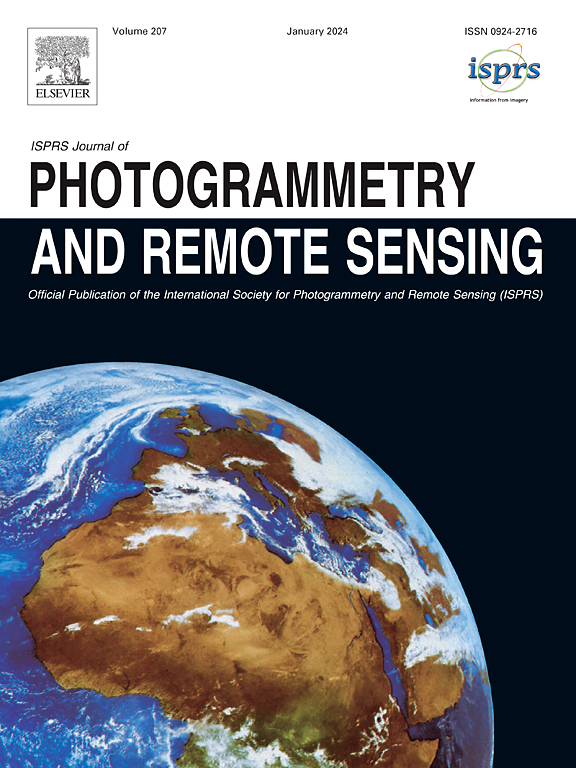Satellite-Based energy balance for estimating actual sugarcane evapotranspiration in the Ethiopian Rift Valley
IF 10.6
1区 地球科学
Q1 GEOGRAPHY, PHYSICAL
ISPRS Journal of Photogrammetry and Remote Sensing
Pub Date : 2025-03-13
DOI:10.1016/j.isprsjprs.2025.03.003
引用次数: 0
Abstract
Satellite-derived actual evapotranspiration (ETa) maps are essential for the development of innovative water management strategies. Over the past decades, multiple novel satellite remote sensing-based surface energy balance (SEB) ETa modeling tools have been widely used to account for field-scale crop water use and irrigation monitoring. However, their predictive capabilities for intensively irrigated commercial sugarcane plantations in the semiarid ecosystems of the Main Ethiopian Rift remain unclear. In this study, we applied and evaluated the comparative performance of four well-established SEB models–SEBAL (Surface Energy Balance Algorithm for Land), METRIC (Mapping Evapotranspiration with Internalized Calibration), SSEB (Simplified Surface Energy Balance), and SSEBop (Operational Simplified Surface Energy Balance)–to estimate ETa using Landsat imagery and weather measurements for the 2021–2022 season, along with an independent validation benchmark, actual evapotranspiration and interception (ETIa), and sugarcane evapotranspiration (ETc) data over irrigated sugarcane monoculture fields at the Metehara Sugar Estate in the Ethiopian Rift Valley. Cumulatively, the Landsat ETa maps derived from the SEB models tracked spatially explicit patterns in the temporal dynamics of sugarcane water use footprint with a higher coefficient of determination (R2) of ≥ 0.90, with irrigation consumption accounting for more than 80 % of the water fluxes. At the field scale, SSEBop estimated average ETa with superior accuracy (R2 ≥ 0.96; root mean square error (RMSE) = 0.29–5.9 mm; Nash-Sutcliffe model efficiency coefficient (NSE) = 0.86–0.92), resulting in a strong agreement with ETIa (d = 0.95–0.98) and lower percentage bias (PBIAS ≈ 4 %), followed by SSEB (R2 ≥ 0.91; RMSE = 0.25–12 mm, NSE = 0.64–0.89, PBIAS ≤ 8 %), while SEBAL and METRIC estimated ETa with higher relative mean errors (RMSE = 0.83–24 mm) and PBIAS of 17 %. We found a reasonable concordance of the model-predicted average ETa with ETIa and ETc values during the early sugarcane growth phases, with a higher deviation during the mid-peak atmospheric demand season and late growth phases. The estimated annual ETa (mm yr−1) ranged from 1303 to 1628 (2021) and 1185–1737 (2022), resulting in a two-year (2021–2022) average-of 1318–1682 mm and seasonal ETa of 2238–2673 mm. Furthermore, we established a hierarchical rating method based on selected performance -metrics, which ranked the proposed models as follows: SSEBop > SSEB > METRIC > SEBAL. In this sense, our findings showed how the optimal method for estimating ETa, which serves as a proxy for -consumptive water use, can be prioritized for irrigated dryland crops with limited in situ measurements by assimilating model sets with publicly available Earth observation satellite imagery and locally recorded weather data.
估算埃塞俄比亚大裂谷甘蔗实际蒸散量的卫星能量平衡
卫星获取的实际蒸散量图对于制定创新的水管理战略至关重要。在过去的几十年里,多种新型的基于卫星遥感的地表能量平衡(SEB) ETa建模工具被广泛应用于农田尺度的作物用水和灌溉监测。然而,它们对埃塞俄比亚主裂谷半干旱生态系统中集约灌溉的商业甘蔗种植园的预测能力尚不清楚。在这项研究中,我们应用并评估了四种成熟的SEB模型——sebal(陆地表面能量平衡算法)、METRIC(利用内化校准绘制蒸散发)、SSEB(简化表面能量平衡)和SSEBop(操作简化表面能量平衡)的比较性能,利用Landsat图像和2021-2022季节的天气测量数据,以及一个独立的验证基准来估计ETa。埃塞俄比亚大裂谷梅特哈拉糖业的实际蒸散量和截止量(ETIa)以及甘蔗蒸散量(ETc)数据。累积而言,基于SEB模型的Landsat ETa地图追踪了甘蔗水利用足迹时间动态的空间明确模式,其决定系数(R2)≥0.90,其中灌溉消耗占水通量的80%以上。在野外尺度上,SSEBop估算的平均ETa精度较高(R2≥0.96;均方根误差(RMSE) = 0.29-5.9 mm;Nash-Sutcliffe模型效率系数(NSE) = 0.86-0.92),结果与eta (d = 0.95-0.98)非常吻合,偏差百分比较低(PBIAS≈4%),其次是SSEB (R2≥0.91;RMSE = 0.25-12 mm, NSE = 0.64-0.89, PBIAS≤8%),而SEBAL和METRIC估计的ETa具有较高的相对平均误差(RMSE = 0.83-24 mm), PBIAS为17%。模型预测的平均ETa与ETIa和ETc值在甘蔗生长前期具有较好的一致性,在大气需求季中峰和生长后期偏差较大。估计的年ETa (mm yr - 1)范围为1303 - 1628(2021年)和1185-1737(2022年),导致两年(2021 - 2022年)平均ETa为1318-1682 mm,季节性ETa为2238-2673 mm。此外,我们建立了一种基于选定的性能指标的分层评级方法,该方法对所提出的模型进行了排名:SSEB祝辞度量的在SEBAL。从这个意义上说,我们的研究结果表明,如何通过将模型集与公开的地球观测卫星图像和当地记录的天气数据相结合,在有限的原位测量条件下,优先考虑估算ETa的最佳方法,该方法可以作为用水量的代理。
本文章由计算机程序翻译,如有差异,请以英文原文为准。
求助全文
约1分钟内获得全文
求助全文
来源期刊

ISPRS Journal of Photogrammetry and Remote Sensing
工程技术-成像科学与照相技术
CiteScore
21.00
自引率
6.30%
发文量
273
审稿时长
40 days
期刊介绍:
The ISPRS Journal of Photogrammetry and Remote Sensing (P&RS) serves as the official journal of the International Society for Photogrammetry and Remote Sensing (ISPRS). It acts as a platform for scientists and professionals worldwide who are involved in various disciplines that utilize photogrammetry, remote sensing, spatial information systems, computer vision, and related fields. The journal aims to facilitate communication and dissemination of advancements in these disciplines, while also acting as a comprehensive source of reference and archive.
P&RS endeavors to publish high-quality, peer-reviewed research papers that are preferably original and have not been published before. These papers can cover scientific/research, technological development, or application/practical aspects. Additionally, the journal welcomes papers that are based on presentations from ISPRS meetings, as long as they are considered significant contributions to the aforementioned fields.
In particular, P&RS encourages the submission of papers that are of broad scientific interest, showcase innovative applications (especially in emerging fields), have an interdisciplinary focus, discuss topics that have received limited attention in P&RS or related journals, or explore new directions in scientific or professional realms. It is preferred that theoretical papers include practical applications, while papers focusing on systems and applications should include a theoretical background.
 求助内容:
求助内容: 应助结果提醒方式:
应助结果提醒方式:


